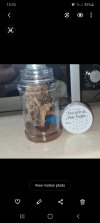- Messages
- 98
- Location
- Kidderminster, Worcestershire
Shes in that 2cm , ill buy her a bigger enclosure then.What has worked well for me: I have used an enclosure for my Avics that is larger than I would normally choose, so the spider does look a bit lost. Plenty of space around the spider also means better ventilation and room for a larger than normal water dish. So - try choosing the next size up enclosure, providing the holes arent too big. I have never had a death using this method.

